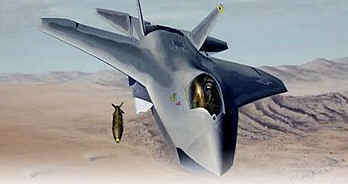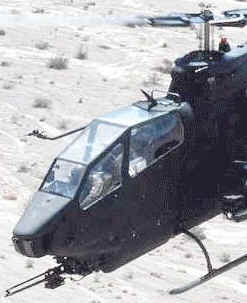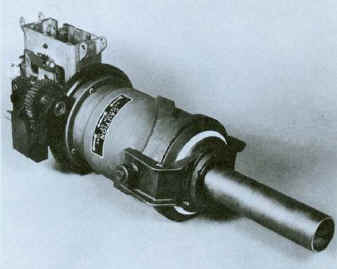Our military is spending billions of dollars to develop the Joint Strike Fighter (JSF). One revolutionary addition could be a chin-mounted gun on a turret. Today's jet aircraft continue the World War I concept of fixed guns which require the pilot to maneuver his aircraft to aim. If he had a helmet targeting system to aim a gun on a turret, he could employ the gun far more effectively. In an air-to-air duel, he would not need to make tight turns to line up his gun, he could just look and shoot. During a ground attack, he could put several rounds on a target instead of hoping that a couple rounds find their mark during a strafing run.
 Turreted guns and aiming helmets have already been proven with a 30mm on Apaches
and a 20mm on Cobra helicopters (below). Since jets fly faster, aerodynamics are
an issue. Perhaps the gun could pop down from the fuselage when needed, or
enclosed in a aerodynamic pod. Recoil problems may require smaller guns
like a .50 caliber.
Turreted guns and aiming helmets have already been proven with a 30mm on Apaches
and a 20mm on Cobra helicopters (below). Since jets fly faster, aerodynamics are
an issue. Perhaps the gun could pop down from the fuselage when needed, or
enclosed in a aerodynamic pod. Recoil problems may require smaller guns
like a .50 caliber.
A similar innovation would involve a tail gun with an infra-red targeting system. If a "bogey" gets on the tail of a JSF, the pilot could switch on the tail gun on automatic while taking evasive maneuvers. Or, the gun could include a tiny camera linked to a small flat video screen in the cockpit serving as a gun sight so the pilot could fire it manually. Two seat aircraft would allow the backseater to fill the World War I role of aiming and firing the tail gun, and he could also control a 360 degree "blister" mounted underneath the aircraft, like those used by World War II bombers.
Since the rounds would trail out behind a fast moving jet, they do not need to be fired from a high powered cannon. The M129 automatic grenade launcher (below) has been used by attack helicopters, and spews out 400 40mm rounds a minute. It can also replace the current chaff/flare dispensers. The M129 could fire mixed belts which alternate between chaff, flares, and high-explosive rounds with proximity fuses. Since MK-19 fires 40mm rounds over 2000 meters, it could keep dozens of rounds in the air between the JSF and pursuing threats, unlike current chaff/IR dispensers whose rounds just fall to earth.
 Even
if the tail gun fails to hit a bogey, the sight of 40mm rounds flying by would
discourage pursuit, especially the threat of ingesting debris into jet engines.
Tail guns would also prove effective in the suppression of enemy air defense.
After an aircraft drops its bomb load and pulls away, an infra-red seeking tail
gun could engage hot spots below, like AAA guns, missiles, and vehicles.
Even
if the tail gun fails to hit a bogey, the sight of 40mm rounds flying by would
discourage pursuit, especially the threat of ingesting debris into jet engines.
Tail guns would also prove effective in the suppression of enemy air defense.
After an aircraft drops its bomb load and pulls away, an infra-red seeking tail
gun could engage hot spots below, like AAA guns, missiles, and vehicles.
Turreted guns and tail guns are not new ideas, they were used in all World War II era bombers. While fighter/bombers do not have the room for human gunners, modern sensors and computers can duplicate their functions, or backseaters can operate them remotely. Future military aircraft designers must think beyond today's concepts and experiment with these ideas.
Carlton Meyer editorG2mil@Gmail.comLetters
JSF Guns
Carlton Meyer suggested that a gun turret be mounted on the Joint Strike Fighter. I'm not sure that a fully traversing turret would be practical on a small supersonic aircraft, but a cannon mounted on the side of the body so that it can be depressed or even elevated has potential. Better still, have a cannon on each side to maintain symmetry, for redundancy, and because two guns firing for half a second are more likely to take out a fast moving jet than one firing for a second.
An aircraft equipped with depressing gun mounts can fire at a ground
target without losing altitude, or can keep its guns trained on a
target for a longer duration.
Mr Meyer also suggests as 40mm grenade launcher as a tailgun for a fighter. This
would be particularly effective if the weapon used Ring Aerofoil Grenades. Ring
Aerofoil Grenades (RAGs) were used as helicopter armament in South East Asia and
have a flatter trajectory and greater range than conventional 40mm grenades. It
is likely these projectiles would be fitted with time fusing so they detonate at
varying distances behind the aircraft, to the detriment of any pursuer.
Phil West phil.west@angelfire.com